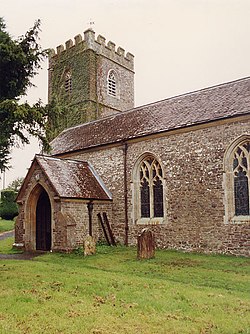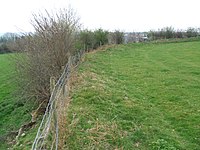Stoodleigh
| Stoodleigh | |
| Devon | |
|---|---|
 Stoodleigh parish church | |
| Location | |
| Grid reference: | SS922190 |
| Data | |
| Population: | -4 |
| Post town: | Tiverton |
| Postcode: | EX16 |
| Dialling code: | 01884 |
| Local Government | |
| Council: | Mid Devon |
| Parliamentary constituency: |
Tiverton and Honiton |
Stoodleigh is a village in the midst of Devon, six miles north of Tiverton and five miles south of Bampton. The village stands at 800 feet above the Exe Valley, close to Devon's border with Somerset. The centre of the village is a conservation area.[1]
The parish is part of Witheridge Hundred.
Castle Close
- Main article: Castle Close

Castle Close is a circular earthwork, close to Stoodleigh, that is most likely to be an Iron Age Hill fort or enclosure.[2]
Parish church
The Church of St Margaret was built in the 15th century and was extensively restored in 1782.[3] It contains a Norman font which is likely to have come from an earlier church in the parish. The first recorded incumbent of the parish was installed in 1264.[1]
Stoodleigh Beacon
Stoodleigh Beacon is a hill in the parish and is also the name of the manor house which once stood at its top, about two miles west of Stoodleigh village. The house was anciently known as Warbrighsleigh,[4] Warbrightley,[5] Warpsley,[6] etc..
The beacon on the hill, which gives its name, was ordered to be set up by King Edward II (1307-1327) "when he doubted of the landing of his queen Isabel and Sir John (sic) of Henold"[7] This refers to Isabel's Invasion of England in 1326, having betrothed her son Prince Edward (later King Edward II) to Philippa of Hainault, the daughter of William I, Count of Hainaut, from whom she received a substantial dowry and several warships.[8]
In the 16th and 17th centuries the estate of Warbrighsleigh, etc., was the seat of the Broughton family.[9]
Outside links
| ("Wikimedia Commons" has material about Stoodleigh) |
References
- ↑ 1.0 1.1 "About Stoodleigh", Stoodleigh.org
- ↑ Sellman, R.R.: 'Aspects of Devon History' (Devon Books, 1985) ISBN 0-86114-756-1. Chapter: "The Iron Age in Devon" (Map of Iron Age hill forts in Devon)
- ↑ "Stoodleigh St. Margaret's", Rootsweb.com
- ↑ Risdon, Tristram: 'A Survey of Devon' (1632), 1810 edition, p 66
- ↑ Vivian, Lt.Col. J.L. (Ed.): 'The Visitations of the County of Devon: Comprising the Heralds' Visitations of 1531, 1564 & 1620, Exeter, 1895'
- ↑ Vivian, Lt.Col. J.L. (Ed.): 'The Visitations of the County of Devon: Comprising the Heralds' Visitations of 1531, 1564 & 1620, Exeter, 1895' page 400
- ↑ Risdon, Tristram: 'A Survey of Devon' (1632), 1810 edition, p 66
- ↑ Kibler, William W., Mediæval France: an Encyclopedia, London, 1995, p.477.
- ↑ Vivian, Lt.Col. J.L. (Ed.): 'The Visitations of the County of Devon: Comprising the Heralds' Visitations of 1531, 1564 & 1620, Exeter, 1895' page 111
